Tears and Trauma in Karachi: Who is to Blame for the Cycle of Violence?
By Farieha Aziz | News & Politics | Published 14 years ago
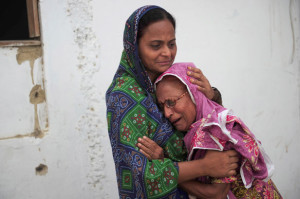 A bride, dressed in all her wedding finery, waited at a parlour in Orangi. Her wedding reception was being held in North Karachi. But violence broke out in the locality and she never made it to her own wedding. Since the nikkah had been performed earlier, she was taken to her new home directly from the parlour. The parents never saw their daughter as a bride. Instead, they played host to an almost empty hall. Elsewhere, Akram’s wife gave birth to a baby girl at 9am. Two hours later, Akram was buried, shot to death in Karachi’s Golimar area the night before without ever seeing his newborn daughter. Akram was just one of the many victims of violence that swept Karachi last month.
A bride, dressed in all her wedding finery, waited at a parlour in Orangi. Her wedding reception was being held in North Karachi. But violence broke out in the locality and she never made it to her own wedding. Since the nikkah had been performed earlier, she was taken to her new home directly from the parlour. The parents never saw their daughter as a bride. Instead, they played host to an almost empty hall. Elsewhere, Akram’s wife gave birth to a baby girl at 9am. Two hours later, Akram was buried, shot to death in Karachi’s Golimar area the night before without ever seeing his newborn daughter. Akram was just one of the many victims of violence that swept Karachi last month.
Every few months, a fresh wave of violence breaks out in the city, traumatising its hapless citizens.
According to a report in Dawn, July 2011 was the bloodiest month since 1995 — more than 200 lives were lost only in the first half of the month, while the death count at the end of the month stood at a harrowing 343. While political parties are quick to claim their dead and quote a figure that exceeds the death count of rival parties, the fact remains that many of those who are killed have no political affiliations at all and are simply caught in the crossfire. And those that survive live in perpetual fear and uncertainty. A report released by the Human Rights Commission of Pakistan (HRCP) on June 5 stated that out of the 490 people killed in the first half of 2011 due to political, ethnic and sectarian violence, 250 of them had no political affiliations. Who is to blame for this continuing cycle of violence?
Listen to those in positions of authority and you will hear about the involvement of a third hand, a conspiracy to destabilise the city and a tussle between elusive land mafias. But ask citizens residing in conflict areas, and they will tell you exactly what is going on and who is behind it. However, while many of the goings-on are discussed in casual conversation, when the time comes to go on record, on camera or in print, there are few who will divulge information. There is a constant refrain: “We have to live here.” Newsline managed to speak to residents of Qasba, Orangi, Katti Pahari, North Nazimabad, Moosa Lane and Lyari, but all of them spoke on condition of anonymity.
Says Moin, a resident of Orangi, there is no problem inside the colony he lives in, but getting to his house is. Moin has to pass through either Qasba or Benaras. Qasba houses both Pathan and Mohajir communities, whereas Benaras is a predominantly Pathan settlement. Katti Pahari poses another problem: armed men up on the hills find easy targets down on the bridge to Qasba or on the main roads and colonies across from it.
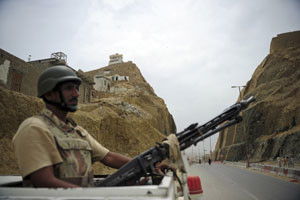 Last year, says Moin, he could not make it to his house for a week and stayed with his in-laws, while his wife and kids were stuck at home in Orangi. On one occasion, he walked from his office to his house, as there was no sign of any public transport and the only vehicles on the streets were those being burned. It took him five-and-a half hours to get home, and along the way he had to dodge bullets, hide behind walls and seek refuge behind groups of women, as criminals went on a rampage.
Last year, says Moin, he could not make it to his house for a week and stayed with his in-laws, while his wife and kids were stuck at home in Orangi. On one occasion, he walked from his office to his house, as there was no sign of any public transport and the only vehicles on the streets were those being burned. It took him five-and-a half hours to get home, and along the way he had to dodge bullets, hide behind walls and seek refuge behind groups of women, as criminals went on a rampage.
While most residents contend that the dispute is at the party level — the ANP (Awami National Party) vs the MQM (Muttahida Quami Movement) — and that there exists no hostility between the two communities, this too is changing. Noor Khan tells Newsline about the ordeal his cousin Gul (a Pathan), who lives on one side of Katti Pahari, had to endure. In the second week of the month, when violence was at its peak in the area, armed men, who Gul revealed spoke Pashto, broke into his house, raided it and beat him and his family. They then broke down his wall, jumped over to the neighbours’ house, and after looting them, set the house on fire. The neighbours, who belong to the Mohajir community and with whom Gul had enjoyed cordial relations for the past many years raised an accusatory finger at him. “Your people did this,” they said. Gul protested that the men had looted his house as well and beaten him and his family. Their only response was, “But they didn’t burn your house.” Since the incident, Noor Khan tried to contact Gul several times, but always found his mobile switched off. From Gul’s brother, Noor Khan learned that he’s been in a state of despondency, fearful of charges being pressed against him.
The conflict in the northern belt of the city, comprising Katti Pahari, Qasba, Orangi, Benaras and North Nazimabad, has assumed a frightening shape over the last few years. In 2008, gruesome acts such as the chopping off of people’s limbs and the burning of people alive were reported. The same year, rumours of people’s (including children’s) ears and tongues being severed were circulating, and dead bodies had been recovered on which ears and mouths had been sealed with Elfy glue.
Speaking to Newsline, the director of the HRCP, I.A. Rehman, reveals the horrifying extent to which ethnic rivalry and stratification has reached in Karachi. “It’s come down to one community disallowing the other from being treated at hospitals, burying their dead in graveyards and sending their children to schools in their areas. Both communities don’t allow it.”
Ethnic profiling, on the basis of which people are targeted, has also risen over the years. There are numerous stories of passengers being pulled off buses, asked to show their ID cards and then being shot because they belonged to a certain ethnic group. The style of clothing has even landed people in trouble. It is generally assumed that those dressed in shalwar kameez are Pathan and those wearing a shirt and trousers are Mohajirs. Regardless of whether they are politically affiliated or not, people from both communities become easy targets on the basis of how they are dressed. To avert unnecessary targeting of residents, in Orangi for example — said to be an MQM stronghold — party workers often issue directives to residents in the area, to dress in shalwar kameez while the situation remains tense.
However, it is not just the manner of dressing that sets the two communities apart. It’s also their choice of careers and their businesses. It is common knowledge that the transport business is Pathan owned as are most of the chai shops and tandoors. There were numerous instances in which buses were torched and the drivers and conductors shot dead. Additionally, naanwalas and chaiwalas and their shops are usually the first to be targeted whenever there is ethnic strife. Says a resident who lives just off Abul Hasan Ispahani Road: “They (Pathans) have all closed shop and left because they were being targeted here. Some were even killed.”
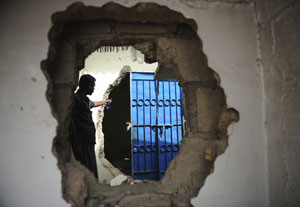 Several young children have also fallen prey to stray bullets. Says Zia, who lives in North Nazimabad in a colony across from Katti Pahari: “My friend was standing outside in our lane with his one-and-a half-year-old sister. Suddenly firing began and a bullet came and pierced her leg.” The ordeal it was to rush the child to the hospital amidst heavy firing is another story altogether. While this child was treated and survived, many others were not as fortunate.
Several young children have also fallen prey to stray bullets. Says Zia, who lives in North Nazimabad in a colony across from Katti Pahari: “My friend was standing outside in our lane with his one-and-a half-year-old sister. Suddenly firing began and a bullet came and pierced her leg.” The ordeal it was to rush the child to the hospital amidst heavy firing is another story altogether. While this child was treated and survived, many others were not as fortunate.
Naturally, when the situation is so volatile, deliveries of daily-use items to shops are also halted and residents become desperate for rations. While buying in bulk and storing would seem to be the sensible thing to do, and some residents have started to do that, Moin says, “You can’t buy in bulk if you are a daily-wage earner; you don’t have the finances for it.” People who have jobs can afford to take a few days off, but those who depend on daily wages can’t. Each time Karachi shuts down, there are many who not only go hungry, but set out to work on an empty stomach to earn their next meal.
For those living in areas that are immediately gripped by violence, the writ of the state is an alien concept. There, it is not the law of the land that prevails but the law of the political party (or armed group) whose stronghold it is. While in some areas the governors and the governed are at peace with one another, there are others where groups are still trying to wrest control without really bothering to win hearts and minds.
Moosa Lane, a name that appeared in news tickers on television often this month, is one such example where the governors and the governed are not at peace. Here, as alleged by residents, the Peoples Amn Committee has established its writ — or rather reign of terror. Says one resident: “They’ve established offices outside in which 10-15 armed men are found at all times. They knock on your door at odd hours and expect you to immediately provide a good meal for 10-15 men. Then they usually climb to the rooftop, feast, sleep or leave.” The residents of another nearby building were not just asked for food though. At midnight, the entire building was emptied and homes were taken over.
Forcible occupancy is rampant all over the city, and buildings at prime locations — and of prime worth — are being taken over. Contrary to the assertion that land mafias are involved in land grabbing, there is no denying that political parties too are involved. Citizens will tell you point-blank that it is a tussle between various groups to seize control of one another’s area, to extend their vote-bank and clout. The clashes Karachi witnessed late last month, in Malir, Khokrapar and Shah Faisal Colony, etc., were ostensibly between the MQM and MQM-Haqiqi, with the latter attempting to make inroads into areas it had been turned out of. And it is believed that the conflict in Lyari and its adjoining areas between the Peoples Amn Committee and the Kutchi Rabita Committee is also a tussle for control.
Says a resident of Qasba — who is neither Mohajir nor Pathan — up until 2008, the MQM was in control of the area. However, now it is the ANP that wins elections from there. Those who have left the area have had to sell their properties to Pathan settlers.
But relocating elsewhere in the city is not easy. The Qasba resident says that property prices have slumped and on top of it, houses are sold at a “compromised” price. Additionally, residents who wish to sell and relocate not only have to sell their property to the party but also deposit an exit fee starting at Rs 25,000-30,000, without which they can leave but their belongings remain where they are. Noor Khan relates how elsewhere in the city, acquantainces of his had to sell their property worth one crore rupees for 13 lakhs. Money, however, is not the only problem. The rival party is gunning for those members of ‘their community,’ who in their view are strengthening their opponent’s hold in the area by selling to them, even if it is merely out of fear.
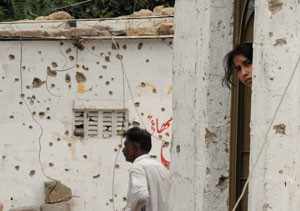 In all such party-operated areas, bhatta goes by the name of ‘protection money,’ and can be given in the form of fitrana or animal skin on Eid to the ruling party (of the colony). It works in the following way: Ready-made slips or parchis are presented to residents of these colonies when they open their doors, and a figure is quoted as fitrana, based on how wealthy the family is. Last month though, a different kind of protection policy was introduced in Qasba. Says a resident, “Workers collected Rs100 from every house for bullets.” It is also alleged that the rival party collected Rs 1,000 per house. Depending on the type and quality of the bullet, one bullet typically costs between Rs 30-50. One lane, 10 houses, multiple lanes — do the math.
In all such party-operated areas, bhatta goes by the name of ‘protection money,’ and can be given in the form of fitrana or animal skin on Eid to the ruling party (of the colony). It works in the following way: Ready-made slips or parchis are presented to residents of these colonies when they open their doors, and a figure is quoted as fitrana, based on how wealthy the family is. Last month though, a different kind of protection policy was introduced in Qasba. Says a resident, “Workers collected Rs100 from every house for bullets.” It is also alleged that the rival party collected Rs 1,000 per house. Depending on the type and quality of the bullet, one bullet typically costs between Rs 30-50. One lane, 10 houses, multiple lanes — do the math.
A form of party policing was also in place in several areas of the city, especially during days of intense violence. It was standard practice to stop passersby, check their ID cards and area of residence, and take action accordingly. This strict vigilance was to ensure that nobody from the rival party entered the area, whether to create mayhem or to spy. In some localities, such checking led to torture, abduction and even death.
Residents of Moosa Lane report that this kind of checking — of ID cards and other papers by members of the Amn Committee — was introduced to pick out those belonging to the Kutchi community. “If someone didn’t have the correct papers or couldn’t prove somehow that he was not involved in any activities against them, he was abducted and tortured.” He went on to say that at times visitors were asked to call those relatives they were visiting to prove that they had a legitimate reason to come into the area. “I can’t even leave,” says the resident. “I don’t know if upon my return my house will still be mine.” And so life continues, for him and others, by trying to keep a low profile and avoid even eye contact, lest they be accused of something they haven’t done.
There is a common denominator in the stories narrated by residents hailing from the different areas: the presence of armed men/groups and the absence of the police and Rangers. And even when the forces are finally deployed, they are confined to the main roads whereas the lanes are the hub of all activity. For the first time, 200 police commandoes made their way inside Lyari, not to conduct an operation, but to sit and scare. But that was after Lyari’s blitzkrieg.
This is what one sweeper had to say to a resident of Lyari Newsline spoke to: “It’s Eid for me tomorrow.” The local explains: “One night’s firing during the Indo-Pak match in Karachi earned the sweeper Rs 25,000-30,000. He was probably out on a treasure hunt early in the morning (the night after heavy firing in Lyari) collecting bullets to sell to the scrapyard,” he says.
Armed men roam unrestrained, brandishing their weapons, says the local. And while it is the Amn Committee that receives flak for the law-and-order situation in Lyari, according to the local, the firing always begins from the other side. In fact, he adds, members of the Amn Committee don’t even make you close down businesses. “They didn’t even force people to keep their businesses closed when Rehman was killed.”
Says another resident, “The media often comes into Lyari to cover football. Not once has it shown the real landscape of the area.” He mentions an amenity plot/shopping plaza next to Lyari’s famous Khadda Market, which is allegedly the bone of contention between the Peoples Amn Committee and the Kutchi Rabita Committee, while also serving as a buffer between the two communities’ residences. He says the building is riddled with bullets, as are several other buildings in the area, but this is never shown. Why don’t the residents who have camera phones release the footage themselves? To this, he responds grimly: “They’ll know exactly whose house or lane the video was made from and also who made it.”
More astonishing than the fact that this area is flush with weapons is what one local reveals about how arms are transported. Here is an eyewitness account: “I saw an ambulance parked in Lyari. Ostensibly there was a dead body in it. I could not believe what I saw later. The dead body got up and picked up Kalashnikovs that the ambulance was laden with.” He continues: “Ambulance drivers are paid up to Rs 30,000 to carry arms and ammunition.”
Kalashnikovs, grenades and rocket launchers are in common use, not just in Lyari but also elsewhere in the city, and some report that other sophisticated arms, especially automatic weapons, are also readily available. According to one citizen, it is the parties who provide their workers with weapons. “Otherwise how else would a boy who takes a 200-rupee loan for rations be able to afford weapons worth one-and-a half to two-and-a half lakh rupees?”
All this, after instructions issued by IG Sindh, Wajid Ali Durrani to the police on July 3, to enforce the ban on the display of weapons in the city, which also applied to private security guards. In fact, the Kutchi Rabita Committee rally came under heavy fire under police watch, and there was renewed violence in the northern belt of the city despite there being two Rangers checkposts.
What Karachi witnessed this month was an eruption like never before. What began as a Pathan-Mohajir, ANP-MQM face off, turned into one between the PPP and the MQM, or rather the MQM against Zulfiqar Mirza and the Peoples Amn Committee. This was followed by a confrontation between the Amn Committee and the Kutchi Rabita Committee and, finally, in the last days of the month, it was the MQM-Haqiqi that was at loggerheads with the MQM.
Citizens, on their part, tried all they could to put an end to the bloodshed. In Qasba, mosques kept giving the azan, which resulted in a ceasefire, but only momentarily; the firing resumed soon after. When ambulances were being fired upon and people were being killed indiscriminately due to constant firing, many bled to death on main roads, as there was nobody to pick them up. But all humanity was not lost. There were those who risked their lives rather than leave the wounded to die on the streets.
Narrates Noor Khan, “As a bus stopped in Orangi and passengers alighted, men opened fire at them. A man was lying near the roundabout. He was alive but even the ambulance couldn’t get to him because they were firing at it too. I saw this man — a resident of the area — walk towards him. He was told he would be shot if he touched the body but he told them ‘I don’t care, I can’t leave him.’ Eventually, he was able to put the injured man in an ambulance.” Where ambulances weren’t available, the injured were transported on pushcarts.
Meanwhile, the government, apart from taking ‘notice,’ banning pillion-riding and forming peace committees to bring the political parties to the table — that too at the 11th hour, after the violence had taken its course — did little else. Days before Landhi and the adjoining areas erupted, there was a buzz among citizens: ‘morchas’ (guerilla posts) had been formed on the roofs of buildings, with armed party workers on the watch. How is it that while common citizens were aware of exactly what was going on where, the government and police were blissfully unaware? And while some residents complain of police inaction, others accuse them of collusion.
Over the past few years, several times there have been raids, arrests of the miscreants etc. Recently, there were door-to-door raids in Malir. But what have they led to? Not only has the incidence of violence increased, street crime is on the rise and now the police require the assistance of lady constables to make arrests, because whenever they enter the lanes to arrest the accused, they are confronted by their female relatives who storm out of their houses in protest.
Some residents are in favour of permanent Rangers checkposts, especially at places such as Katti Pahari. They say even though the Rangers don’t enter the lanes, the minute they are deployed, there is a ceasefire and the criminal elements flee. On several occasions, there have been calls for operations, but citizens are critical of the manner in which they are conducted — there are prior warmings about the operation on TV, allowing the criminal elements ample time to run away. The other argument against the operations is that they are never across the board and target mostly innocent people.
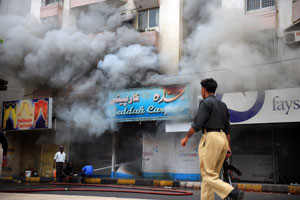 Moin recalls the army operation launched against the MQM in ’95. There were door-to-door raids in Orangi. While the first set of men in boots behaved politely, the second group to make the rounds wasn’t as courteous. Moin was picked up, blindfolded, beaten for four hours and then taken to the seniors who decided he was innocent. “They opened my blindfold, and with one kick I found myself at the bottom of the stairs, unable to decipher whether I had gone blind or what. I couldn’t get up from my bed for the next three days.”
Moin recalls the army operation launched against the MQM in ’95. There were door-to-door raids in Orangi. While the first set of men in boots behaved politely, the second group to make the rounds wasn’t as courteous. Moin was picked up, blindfolded, beaten for four hours and then taken to the seniors who decided he was innocent. “They opened my blindfold, and with one kick I found myself at the bottom of the stairs, unable to decipher whether I had gone blind or what. I couldn’t get up from my bed for the next three days.”
For the past three to four years now, widespread violence has been a constant feature of Karachi life. Day-long strikes and forced shutter-downs, blocked roads, stone-pelting, torched tyres, vehicles and houses, and indiscriminate firing and killing have become the norm. This July, as violence engulfed various pockets of the city, residents in the troubled areas fled their homes; those who didn’t have a place to relocate to, confined themselves within their four walls.
Citizens are seething with rage. They go along with the political actors not because their hearts and minds are with them, but out of fear. The path of least resistance is their only option at the moment because it becomes a question of life and death for them. But the kind of life Karachi’s citizens are being forced to lead is no life at all. It’s a veritable hell. People have lost their loved ones to violence, street crime, break-ins and kidnappings for ransom.
In an interview with Newsline in February 2010, former CCPO Karachi Waseem Ahmed conceded that criminals existed within the rank and file of every political party. Though part of the state apparatus, the police has always been used by successive ruling parties against rival groups to further their own political (party) agendas. There is a firm belief among many that Karachi’s peace is in the hands of its political actors — they have the power to make or break it. This has been proven, time and again. People are a witness to the frequent pacts, agreements and compromises made between foes, who become ‘brothers’ the very next day. They are cognisant of the calls issued by party heads to workers, to rein them in or to let them run amok, spilling the blood of innocents on the streets.
They have seen enough of violence and bloodletting. And now they feel it’s time to move beyond notices, bans on pillion-riding, high-level meetings and APCs. It’s also time to put an end to poisonous speeches instigating party workers to go out on a bloody rampage. Party politics needs to be separated from state politics. The faster the government and political parties were to realise the consequences of the grave catastrophe that is unfolding due to their selfish motives, the better it would be for the hapless citizens of this beleaguered city.
This article was originally published in the August 2011 issue of Newsline under the headline “Tears and Trauma.”
Farieha Aziz is a Karachi-based journalist and teacher. She joined Newsline in 2007, rising to assistant editor. Farieha was awarded the APNS award for Best Investigative Report (Business/Economic) for the year 2007-2008. She is a co-founder and Director at Bolo Bhi, an advocacy forum of Digital Rights.


